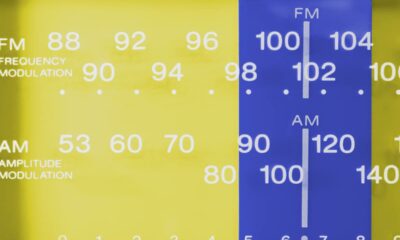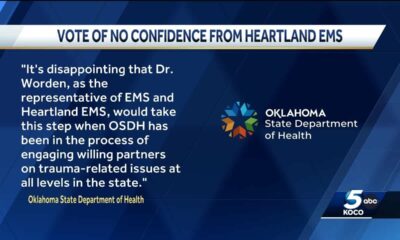Kaiser Health News
How a Friend’s Death Turned Colorado Teens Into Anti-Overdose Activists
Rae Ellen Bichell
Fri, 01 Mar 2024 10:00:00 +0000
Gavinn McKinney loved Nike shoes, fireworks, and sushi. He was studying Potawatomi, one of the languages of his Native American heritage. He loved holding his niece and smelling her baby smell. On his 15th birthday, the Durango, Colorado, teen spent a cold December afternoon chopping wood to help neighbors who couldn’t afford to heat their homes.
McKinney almost made it to his 16th birthday. He died of fentanyl poisoning at a friend’s house in December 2021. His friends say it was the first time he tried hard drugs. The memorial service was so packed people had to stand outside the funeral home.
Now, his peers are trying to cement their friend’s legacy in state law. They recently testified to state lawmakers in support of a bill they helped write to ensure students can carry naloxone with them at all times without fear of discipline or confiscation. School districts tend to have strict medication policies. Without special permission, Colorado students can’t even carry their own emergency medications, such as an inhaler, and they are not allowed to share them with others.
“We realized we could actually make a change if we put our hearts to it,” said Niko Peterson, a senior at Animas High School in Durango and one of McKinney’s friends who helped write the bill. “Being proactive versus being reactive is going to be the best possible solution.”
Individual school districts or counties in California, Maryland, and elsewhere have rules expressly allowing high school students to carry naloxone. But Jon Woodruff, managing attorney at the Legislative Analysis and Public Policy Association, said he wasn’t aware of any statewide law such as the one Colorado is considering. Woodruff’s Washington, D.C.-based organization researches and drafts legislation on substance use.
Naloxone is an opioid antagonist that can halt an overdose. Available over the counter as a nasal spray, it is considered the fire extinguisher of the opioid epidemic, for use in an emergency, but just one tool in a prevention strategy. (People often refer to it as “Narcan,” one of the more recognizable brand names, similar to how tissues, regardless of brand, are often called “Kleenex.”)
The Biden administration last year backed an ad campaign encouraging young people to carry the emergency medication.
Most states’ naloxone access laws protect do-gooders, including youth, from liability if they accidentally harm someone while administering naloxone. But without school policies explicitly allowing it, the students’ ability to bring naloxone to class falls into a gray area.
Ryan Christoff said that in September 2022 fellow staff at Centaurus High School in Lafayette, Colorado, where he worked and which one of his daughters attended at the time, confiscated naloxone from one of her classmates.
“She didn’t have anything on her other than the Narcan, and they took it away from her,” said Christoff, who had provided the confiscated Narcan to that student and many others after his daughter nearly died from fentanyl poisoning. “We should want every student to carry it.”
Boulder Valley School District spokesperson Randy Barber said the incident “was a one-off and we’ve done some work since to make sure nurses are aware.” The district now encourages everyone to consider carrying naloxone, he said.
Community’s Devastation Turns to Action
In Durango, McKinney’s death hit the community hard. McKinney’s friends and family said he didn’t do hard drugs. The substance he was hooked on was Tapatío hot sauce — he even brought some in his pocket to a Rockies game.
After McKinney died, people started getting tattoos of the phrase he was known for, which was emblazoned on his favorite sweatshirt: “Love is the cure.” Even a few of his teachers got them. But it was classmates, along with their friends at another high school in town, who turned his loss into a political movement.
“We’re making things happen on behalf of him,” Peterson said.
The mortality rate has spiked in recent years, with more than 1,500 other children and teens in the U.S. dying of fentanyl poisoning the same year as McKinney. Most youth who die of overdoses have no known history of taking opioids, and many of them likely thought they were taking prescription opioids like OxyContin or Percocet — not the fake prescription pills that increasingly carry a lethal dose of fentanyl.
“Most likely the largest group of teens that are dying are really teens that are experimenting, as opposed to teens that have a long-standing opioid use disorder,” said Joseph Friedman, a substance use researcher at UCLA who would like to see schools provide accurate drug education about counterfeit pills, such as with Stanford’s Safety First curriculum.
Allowing students to carry a low-risk, lifesaving drug with them is in many ways the minimum schools can do, he said.
“I would argue that what the schools should be doing is identifying high-risk teens and giving them the Narcan to take home with them and teaching them why it matters,” Friedman said.
Writing in The New England Journal of Medicine, Friedman identified Colorado as a hot spot for high school-aged adolescent overdose deaths, with a mortality rate more than double that of the nation from 2020 to 2022.
“Increasingly, fentanyl is being sold in pill form, and it’s happening to the largest degree in the West,” said Friedman. “I think that the teen overdose crisis is a direct result of that.”
If Colorado lawmakers approve the bill, “I think that’s a really important step,” said Ju Nyeong Park, an assistant professor of medicine at Brown University, who leads a research group focused on how to prevent overdoses. “I hope that the Colorado Legislature does and that other states follow as well.”
Park said comprehensive programs to test drugs for dangerous contaminants, better access to evidence-based treatment for adolescents who develop a substance use disorder, and promotion of harm reduction tools are also important. “For example, there is a national hotline called Never Use Alone that anyone can call anonymously to be supervised remotely in case of an emergency,” she said.
Taking Matters Into Their Own Hands
Many Colorado school districts are training staff how to administer naloxone and are stocking it on school grounds through a program that allows them to acquire it from the state at little to no cost. But it was clear to Peterson and other area high schoolers that having naloxone at school isn’t enough, especially in rural places.
“The teachers who are trained to use Narcan will not be at the parties where the students will be using the drugs,” he said.
And it isn’t enough to expect teens to keep it at home.
“It’s not going to be helpful if it’s in somebody’s house 20 minutes outside of town. It’s going to be helpful if it’s in their backpack always,” said Zoe Ramsey, another of McKinney’s friends and a senior at Animas High School.
“We were informed it was against the rules to carry naloxone, and especially to distribute it,” said Ilias “Leo” Stritikus, who graduated from Durango High School last year.
But students in the area, and their school administrators, were uncertain: Could students get in trouble for carrying the opioid antagonist in their backpacks, or if they distributed it to friends? And could a school or district be held liable if something went wrong?
He, along with Ramsey and Peterson, helped form the group Students Against Overdose. Together, they convinced Animas, which is a charter school, and the surrounding school district, to change policies. Now, with parental permission, and after going through training on how to administer it, students may carry naloxone on school grounds.
Durango School District 9-R spokesperson Karla Sluis said at least 45 students have completed the training.
School districts in other parts of the nation have also determined it’s important to clarify students’ ability to carry naloxone.
“We want to be a part of saving lives,” said Smita Malhotra, chief medical director for Los Angeles Unified School District in California.
Los Angeles County had one of the nation’s highest adolescent overdose death tallies of any U.S. county: From 2020 to 2022, 111 teens ages 14 to 18 died. One of them was a 15-year-old who died in a school bathroom of fentanyl poisoning. Malhotra’s district has since updated its policy on naloxone to permit students to carry and administer it.
“All students can carry naloxone in our school campuses without facing any discipline,” Malhotra said. She said the district is also doubling down on peer support and hosting educational sessions for families and students.
Montgomery County Public Schools in Maryland took a similar approach. School staff had to administer naloxone 18 times over the course of a school year, and five students died over the course of about one semester.
When the district held community forums on the issue, Patricia Kapunan, the district’s medical officer, said, “Students were very vocal about wanting access to naloxone. A student is very unlikely to carry something in their backpack which they think they might get in trouble for.”
So it, too, clarified its policy. While that was underway, local news reported that high school students found a teen passed out, with purple lips, in the bathroom of a McDonald’s down the street from their school, and used Narcan to revive them. It was during lunch on a school day.
“We can’t Narcan our way out of the opioid use crisis,” said Kapunan. “But it was critical to do it first. Just like knowing 911.”
Now, with the support of the district and county health department, students are training other students how to administer naloxone. Jackson Taylor, one of the student trainers, estimated they trained about 200 students over the course of three hours on a recent Saturday.
“It felt amazing, this footstep toward fixing the issue,” Taylor said.
Each trainee left with two doses of naloxone.
This article was produced by KFF Health News, which publishes California Healthline, an editorially independent service of the California Health Care Foundation.
——————————
By: Rae Ellen Bichell
Title: How a Friend’s Death Turned Colorado Teens Into Anti-Overdose Activists
Sourced From: kffhealthnews.org/news/article/teen-overdose-fentanyl-naloxone-narcan-state-legislation/
Published Date: Fri, 01 Mar 2024 10:00:00 +0000
Did you miss our previous article…
https://www.biloxinewsevents.com/bathroom-bills-are-back-broader-and-stricter-in-several-states/
Kaiser Health News
Years Later, Centene Settlements With States Still Unfinished
More than three years ago, health insurance giant Centene Corp. settled allegations that it overcharged Medicaid programs in Ohio and Mississippi related to prescription drug billing.
Now at least 20 states have settled with Centene over its pharmacy benefit manager operation that coordinated the medications for Medicaid patients. Arizona was among the most recent to join the ranks, settling for an undisclosed payout, Richie Taylor, a spokesperson for the state’s attorney general, told KFF Health News in December.
All told, Centene has agreed to pay more than $1 billion in settlements, according to Cohen Milstein, one of the law firms representing states in the agreements. Meanwhile, St. Louis-based Centene reported $163 billion in revenue in 2024, largely proceeds from government health programs for Medicaid, Medicare, and the Affordable Care Act. The health care company has admitted no wrongdoing in the settlements.
Two state holdouts appear to remain: Georgia has yet to settle with Centene, even though the administration of Gov. Brian Kemp hired law firm Liston & Deas in 2019 to investigate state pharmacy benefit operations.
Florida hired the same law firm in 2021 to pursue overbilling allegations involving Centene, but state officials declined to answer a reporter’s questions about whether Florida has dropped the case, reached an undisclosed settlement, or is still discussing the issue.
Neither state has publicly disclosed what’s standing in the way of potentially tens of millions of dollars in Centene payouts, or whether negotiations are taking place. Because the deals are largely occurring outside the court system, the process between the private law firms hired by states and Centene remains generally out of public view.
Centene spokespeople did not return multiple phone calls and emails asking for updates. In 2022, the company said it was working on settlements with Georgia and eight other states, having reached deals with 13 others. And in a Securities and Exchange Commission filing in October, Centene said it had reached settlements with “the vast majority of states impacted” over the operations of its former pharmacy benefits manager.
Georgia has “taken disproportionately long compared to other states,” said Greg Reybold, a vice president of the American Pharmacy Cooperative, which represents independent pharmacies.
Meanwhile, Centene’s Georgia Medicaid plan, the Peach State Health Plan, lost its bid last year to continue its longtime participation in a Georgia Medicaid program in which companies cover the care for Medicaid recipients for a set fee from the government rather than for each medical service provided. The company, which has been part of the contract since the managed-care program began in 2006, filed a protest over the contract awards, saying that the process was “mismanaged, rife with errors and reckless practices.”
Nationally, pharmacy benefit managers, or PBMs, have come under increased scrutiny over accusations of pocketing discounts on medications or inflating costs in the years since Centene started settling its Medicaid-related allegations. Members of Congress have proposed major policy constraints on PBMs. Centene has since overhauled its PBM operation.
Still, a possible settlement in Georgia could bring in significant money to the state. California had the largest publicly disclosed settlement at $215 million, split with the federal government, but a settlement with Georgia could be in the range of the $88 million that Centene agreed to pay in the Ohio dispute, Reybold said.
The state should aggressively pursue a settlement with Centene, said Roland Behm, co-founder of the Georgia Mental Health Policy Partnership, who is a critic of Centene and its Georgia Medicaid plan. Behm said state Attorney General Chris Carr should take “the same tenacious prosecutorial action” against Centene that Carr’s agency takes against individuals involved in fraud against Medicaid, the federal-state program that provides health insurance coverage for those with low incomes or disabilities.
Carr’s office said in 2022 that it stood ready to represent Georgia in settlement negotiations with Centene. Carr, a Republican who has announced he’s running for governor in 2026, received tens of thousands of dollars in campaign contributions from Centene, its subsidiaries, and its executives, as did Kemp, a fellow Republican, KFF Health News reported in 2022. Contributions to the Kemp and Carr campaigns were part of more than $26.9 million that Centene, its subsidiaries, its top executives, and their spouses donated to state politicians in 33 states, to their political parties, and to nonprofit fundraising groups from 2015 through 2022.
Since 2022, the company and its political action committee have contributed, combined, at least $2 million more to the campaigns of Florida and Georgia candidates of both political parties, along with state party organizations and political committees, according to state campaign finance records.
When asked about a possible settlement, a spokesperson for Carr, Kara Murray, directed a reporter to the Georgia Department of Community Health, which administers Medicaid.
Fiona Roberts, a spokesperson for that agency, then told KFF Health News that the department “is actively pursuing options to ensure regulatory compliance with the state’s contract.” She declined to comment further.
Florida’s attorney general’s office directed a reporter to the state agency that oversees Medicaid, the Florida Agency for Health Care Administration. But that agency did not respond to multiple phone calls and emails requesting comment.
Rebecca Grapevine of Healthbeat contributed to this article.
The post Years Later, Centene Settlements With States Still Unfinished appeared first on kffhealthnews.org
Kaiser Health News
Home Improvements Can Help People Age Independently. But Medicare Seldom Picks Up the Bill.
Chikao Tsubaki had been having a terrible time.
In his mid-80s, he had a stroke. Then lymphoma. Then prostate cancer. He was fatigued, isolated, not all that steady on his feet.
Then Tsubaki took part in an innovative care initiative that, over four months, sent an occupational therapist, a nurse, and a handy worker to his home to help figure out what he needed to stay safe. In addition to grab bars and rails, the handy worker built a bookshelf so neither Tsubaki nor the books he cherished would topple over when he reached for them.
Reading “is kind of the back door for my cognitive health — my brain exercise,” said Tsubaki, a longtime community college teacher. Now 87, he lives independently and walks a mile and a half almost every day.
The program that helped Tsubaki remain independent, called Community Aging in Place: Advancing Better Living for Elders, or CAPABLE, has been around for 15 years and is offered in about 65 places across 26 states. It helps people 60 and up, and some younger people with disabilities or limitations, who want to remain at home but have trouble with activities like bathing, dressing, or moving around safely. Several published studies have found the program saves money and prevents falls, which the Centers for Disease Control and Prevention says contribute to the deaths of 41,000 older Americans and cost Medicare about $50 billion each year.
Despite evidence and accolades, CAPABLE remains small, serving roughly 4,600 people to date. Insurance seldom covers it (although the typical cost of $3,500 to $4,000 per client is less than many health care interventions). Traditional Medicare and most Medicare Advantage private insurance plans don’t cover it. Only four states use funds from Medicaid,the federal-state program for low-income and disabled people. CAPABLE gets by on a patchwork of grants from places like state agencies for aging and philanthropies.
The payment obstacles are an object lesson in how insurers, including Medicare, are built around paying for doctors and hospitals treating people who are injured or sick — not around community services that keep people healthy. Medicare has billing codes for treating a broken hip, but not for avoiding one, let alone for something like having a handy person “tack down loose carpet near stairs.”
And while keeping someone alive longer may be a desirable outcome, it’s not necessarily counted as savings under federal budget rules. A 2017 Centers for Medicare & Medicaid Services evaluation found that CAPABLE had high satisfaction rates and some savings. But its limited size made it hard to assess the long-term economic impact.
It’s unclear how the Trump administration will approach senior care.
The barriers to broader state or federal financing are frustrating, said Sarah Szanton, who helped create CAPABLE while working as a nurse practitioner doing home visits in west Baltimore. Some patients struggled to reach the door to open it for her. One tossed keys to her out of a second-story window, she recalled.
Seeking a solution, Szanton discovered a program called ABLE, which brought an occupational therapist and a handy worker to the home. Inspired by its success, Szanton developed CAPABLE, which added a nurse to check on medications, pain, and mental well-being, and do things like help participants communicate with doctors. It began in 2008. Szanton since 2021 has been the dean of Johns Hopkins University School of Nursing, which coordinates research on CAPABLE. The model is participatory, with the client and care team “problem-solving and brainstorming together,” said Amanda Goodenow, an occupational therapist who worked in hospitals and traditional home health before joining CAPABLE in Denver, where she also works for the CAPABLE National Center, the nonprofit that runs the program.
CAPABLE doesn’t profess to fix all the gaps in U.S. long-term care, and it doesn’t work with all older people. Those with dementia, for example, don’t qualify. But studies show it does help participants live more safely at home with greater mobility. And one study that Szanton co-authored estimated Medicare savings of around $20,000 per person would continue for two years after a CAPABLE intervention.
“To us, it’s so obvious the impact that can be made just in a short amount of time and with a small budget,” said Amy Eschbach, a nurse who has worked with CAPABLE clients in the St. Louis area, where a Medicare Advantage plan covers CAPABLE. That St. Louis program caps spending on home modifications at $1,300 a person.
Both Hill staff and CMS experts who have looked at CAPABLE do see potential routes to broader coverage. One senior Democratic House aide, who asked not to be identified because they were not allowed to speak publicly, said Medicare would have to establish careful parameters. For instance, CMS would have to decide which beneficiaries would be eligible. Everyone in Medicare? Or only those with low incomes? Could Medicare somehow ensure that only necessary home modifications are made — and that unscrupulous contractors don’t try to extract the equivalent of a “copay” or “deductible” from clients?
Szanton said there are safeguards and more could be built in. For instance, it’s the therapists like Goodenow, not the handy workers, who put in the work orders to stay on budget.
For Tsubaki, whose books are not only shelved but organized by topic, the benefits have endured.
“I became more independent. I’m able to handle most of my activities. I go shopping, to the library, and so forth,” he said. His pace is slow, he acknowledged. But he gets there.
Kenen is the journalist-in-residence and a faculty member at Johns Hopkins University School of Public Health. She is not affiliated with the CAPABLE program.
The post Home Improvements Can Help People Age Independently. But Medicare Seldom Picks Up the Bill. appeared first on kffhealthnews.org
Kaiser Health News
A Runner Was Hit by a Car, Then by a Surprise Ambulance Bill
Jagdish Whitten was on a run in July 2023 when a car hit him as he crossed a busy San Francisco street. Whitten, then 25, described doing “a little flip” over the vehicle and landing in the street before getting himself to the curb.
Concerned onlookers called an ambulance. But Whitten instead had friends pick him up and take him to a nearby hospital, the Helen Diller Medical Center, operated by the University of California-San Francisco.
“I knew that ambulances were expensive, and I didn’t think I was going to die,” he said.
Whitten said doctors treated him for a mild concussion, a broken toe, and bruises.As he sat in a hospital bed, attached to an IV and wearing a neck brace, Whitten said, doctors told him that because he had suffered a traumatic injury, they had to send him by ambulance to the city’s only trauma center, Zuckerberg San Francisco General Hospital.
After a short ambulance ride, Whitten said, emergency room doctors checked him out, told him he had already received appropriate treatment, and released him.
Then the bill came.
The Medical Procedure
Traumatic injuries are those that threaten life or limb, and some facilities specialize in providing care for them. For someone hit by a car, that can include stabilizing vital signs, screening for internal injuries, and treating broken bones and concussions. Zuckerberg Hospital is a Level 1 trauma center, meaning it can provide any care needed for severely injured patients.
In emergency medicine, it is standard to transfer patients to centers best equipped to provide care. Ambulances are typically used for transfers because they are able to handle trauma patients, with tools to aid in resuscitation, immobilization, and life support.
At the first hospital, Whitten said, doctors performed a thorough workup, including a CT scan and X-rays, and advised him to follow up with his primary care physician and an orthopedic doctor. He was evaluated at the second hospital and released without additional treatment, he said.
The Final Bill
$12,872.99 for a 6-mile ambulance ride between hospitals: a $11,670.11 base rate, $737.16 for mileage, $314.45 for EKG monitoring, and $151.27 for “infection control.”
The Billing Problem: Surprise Bills Are Common With Ground Ambulances
Ground ambulance services are operated by a hodgepodge of private and public entities — with no uniform structure, or regulatory oversight, for billing — and most function outside insurance networks. Patients don’t typically have a choice of ambulance provider.
There are state and federal laws shielding patients from out-of-network ambulance bills, but none of those protections applied in Whitten’s case.
Whitten was insured under his father’s employer-sponsored health plan from Anthem Blue Cross. So when he received a nearly $13,000 bill months after his short transfer ride, he sent a photo of it to his dad.
Brian Whitten said the bills from the two hospitals — and the family’s out-of-pocket responsibility — were in line with what he had anticipated. But he was stunned by his son’s ambulance bill from AMR, one of the nation’s largest ambulance providers. Anthem Blue Cross denied the claim, saying the ambulance was out-of-network and required pre-authorization.
“It didn’t make a whole lot of sense to me, because the doctor is the one who put him in the ambulance,” Brian Whitten said. “It’s not like somehow he just decided, ‘Hey, can I take an ambulance ride?’”
Kristen Bole, a UCSF spokesperson, said in a statement that the health system’s standard of care is to stabilize patients and, when appropriate, transfer them to other medical facilities that are most appropriate to care for patients’ needs, adding that ambulance transfers between hospitals are standard practice.
While the medical system at large relies on negotiated prices for services, ambulance services operate largely outside of the competitive marketplace, said Patricia Kelmar, senior director of health care campaigns for PIRG, a nonpartisan consumer protection and good-government advocacy organization.
Ambulance transfers between hospitals to ensure the highest quality of care available are fairly common, Kelmar said. And with many hospitals being purchased and consolidated, it would follow that the number of ambulance transfers between facilities could increase as specialized medical units at any given hospital are downsized or eliminated, she said.
According to a study of private insurance claims data conducted in 2023, about 80% of ground ambulance rides resulted in out-of-network billing.
Generally, out-of-network providers may charge patients for the remainder of their bill after insurance pays. In some cases, patients can be on the hook even when they did not knowingly choose the out-of-network provider. These bills are known as “surprise” bills.
“It’s a financial burden, a significant financial burden,” said Kelmar, who is a member of the committee created to advise federal lawmakers on surprise bills and emergency ambulance transportation.
Eighteen states have implemented laws regulating surprise ambulance billing. A California law cracking down on surprise ambulance billing took effect on Jan. 1, 2024 — months after Jagdish Whitten’s ambulance ride.But Kelmar said those state laws don’t really help people with employer-sponsored insurance, because those plans are beyond state control — which is why federal legislation is so important, she said.
As of 2022, federal law protects patients from receiving some surprise bills, especially for emergency services. But while lawmakers included protections against air ambulance bills in the law, known as the No Surprises Act, they excluded ground ambulance transports.
The Resolution
Whitten’s father filed an insurance appeal on his son’s behalf, which Anthem granted. The insurer paid AMR $9,966.60.
Michael Bowman, a spokesperson for Anthem, said AMR had not submitted all the information it required to process the claim, leading to the initial denial. After consulting with AMR, Anthem paid its coverage amount, Bowman said.
But the insurer’s payment still left Whitten with a $2,906.39 bill for his out-of-network ambulance ride. Brian Whitten said he called an AMR customer service number several times to contest the remaining charges but was unable to bypass its automated system and speak with a human.
“I couldn’t find a way to talk to somebody about this bill other than how to pay it, and I didn’t want to pay it,” he said.
Unsuccessful and frustrated, Brian Whitten paid the remaining bill in January 2024, he said, concerned it would be turned over to a collection agency and hurt his son’s credit — and his well-being.
There was one more twist: He was shocked when he later reviewed his credit card statements and discovered that AMR had quietly but fully refunded his payment in October.
“It’s amazing that he got his money back,” Kelmar said. “That’s what’s shocking.”
In a statement, Suzie Robinson, vice president of revenue cycle management with AMR, said the company’s third-party billing agency regularly performs audits to ensure accuracy. An audit of Jagdish Whitten’s bill “revealed that the care provided did not meet the criteria for critical care,” Robinson said, which prompted the full refund.
Robinson said audits indicated fewer than 1% of its 4 million medical encounters annually are billed incorrectly.
The Takeaway
Robinson said patients who feel that AMR has billed them incorrectly should contact the company via email.
For patients in need of an ambulance in an emergency, there are few protections — and usually few options: Sometimes you don’t have a better choice than to get in.
Federal protections require that health plans cover certain surprise bills, with patients paying only what they would if they had received in-network care. Expanding those protections to ground ambulance bills would require Congress to act.
Ambulance providers deserve to be appropriately compensated for their vital role in our medical system, Kelmar said. But the system as it stands almost incentivizes providers to charge a higher rate, which can lead to surprise billing and financial hardship for patients and their families, she said.
Kelmar said she worries not just about the debt those bills create for consumers but also that people may decline vital ambulance transportation in an emergency, for fear of getting hit with an exorbitant bill.
“We just need to bring some sense back to the system,” she said.
Bill of the Month is a crowdsourced investigation by KFF Health News and The Washington Post’s Well+Being that dissects and explains medical bills. Since 2018, this series has helped many patients and readers get their medical bills reduced, and it has been cited in statehouses, at the U.S. Capitol, and at the White House. Do you have a confusing or outrageous medical bill you want to share? Tell us about it!
KFF Health News is a national newsroom that produces in-depth journalism about health issues and is one of the core operating programs at KFF—an independent source of health policy research, polling, and journalism. Learn more about KFF.
USE OUR CONTENT
This story can be republished for free (details).
The post A Runner Was Hit by a Car, Then by a Surprise Ambulance Bill appeared first on kffhealthnews.org
-

 News from the South - Virginia News Feed6 days ago
News from the South - Virginia News Feed6 days agoVirginia woman getting ready to celebrate 100th birthday: 'I have really enjoyed life'
-

 Mississippi Today7 days ago
Mississippi Today7 days agoSenate passes redistricting that puts DeSoto Republican, Tunica Democrat in same district, calls for 10 new elections
-

 News from the South - Florida News Feed3 days ago
News from the South - Florida News Feed3 days ago4 killed, 1 hurt in crash after car attempts to overtake another in Orange County, troopers say
-

 Mississippi Today6 days ago
Mississippi Today6 days agoMississippi private prison OK’d to hold more ICE detainees
-

 News from the South - Virginia News Feed5 days ago
News from the South - Virginia News Feed5 days agoStorm chances Wednesday, rollercoaster temperatures this weekend
-

 News from the South - Oklahoma News Feed5 days ago
News from the South - Oklahoma News Feed5 days agoOklahoma Department State Department of Health hit with no confidence vote
-

 Mississippi Today3 days ago
Mississippi Today3 days agoJudge’s ruling gives Legislature permission to meet behind closed doors
-

 News from the South - Oklahoma News Feed6 days ago
News from the South - Oklahoma News Feed6 days agoWarner Bros. demands removal of Chickasha's iconic leg lamp














































